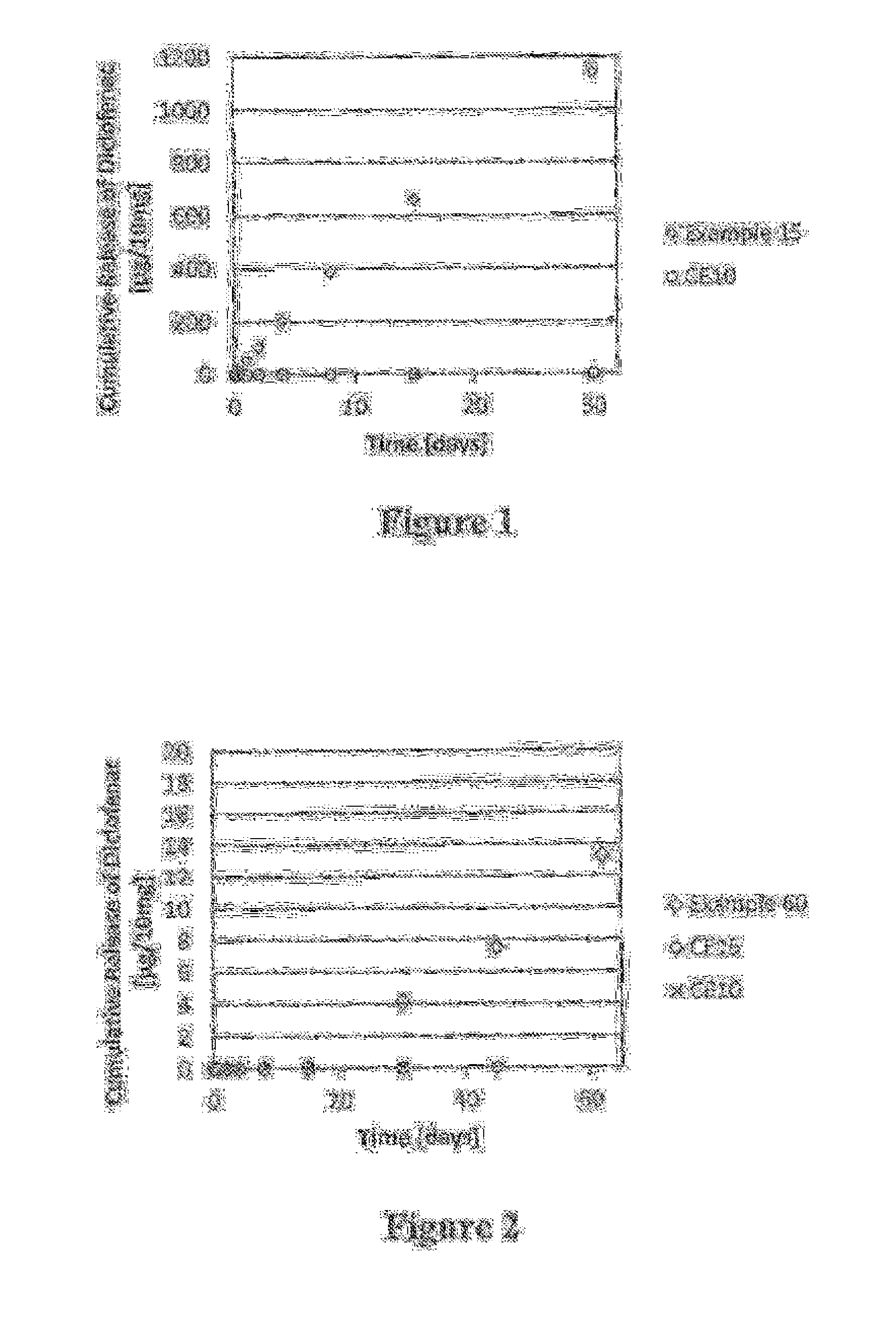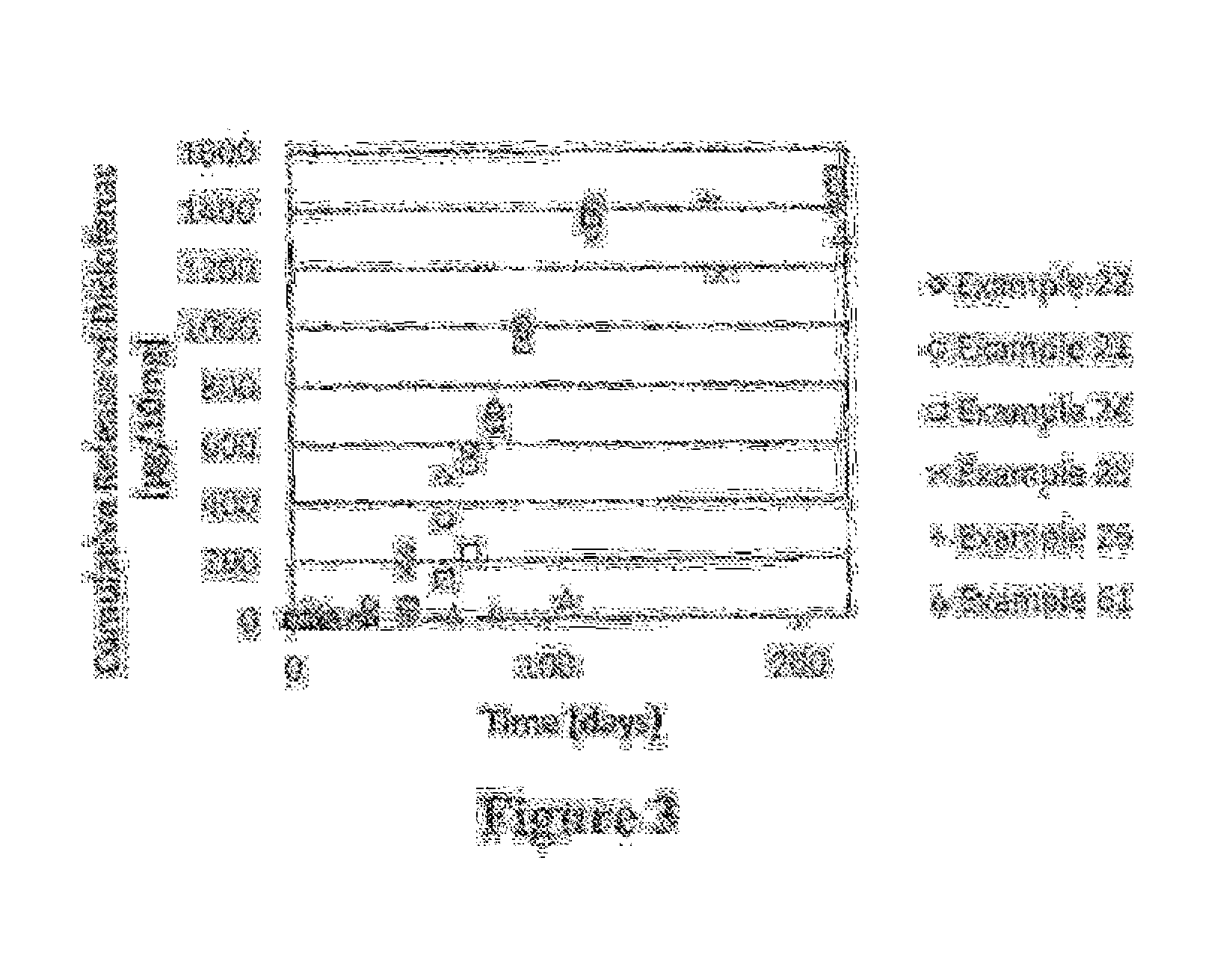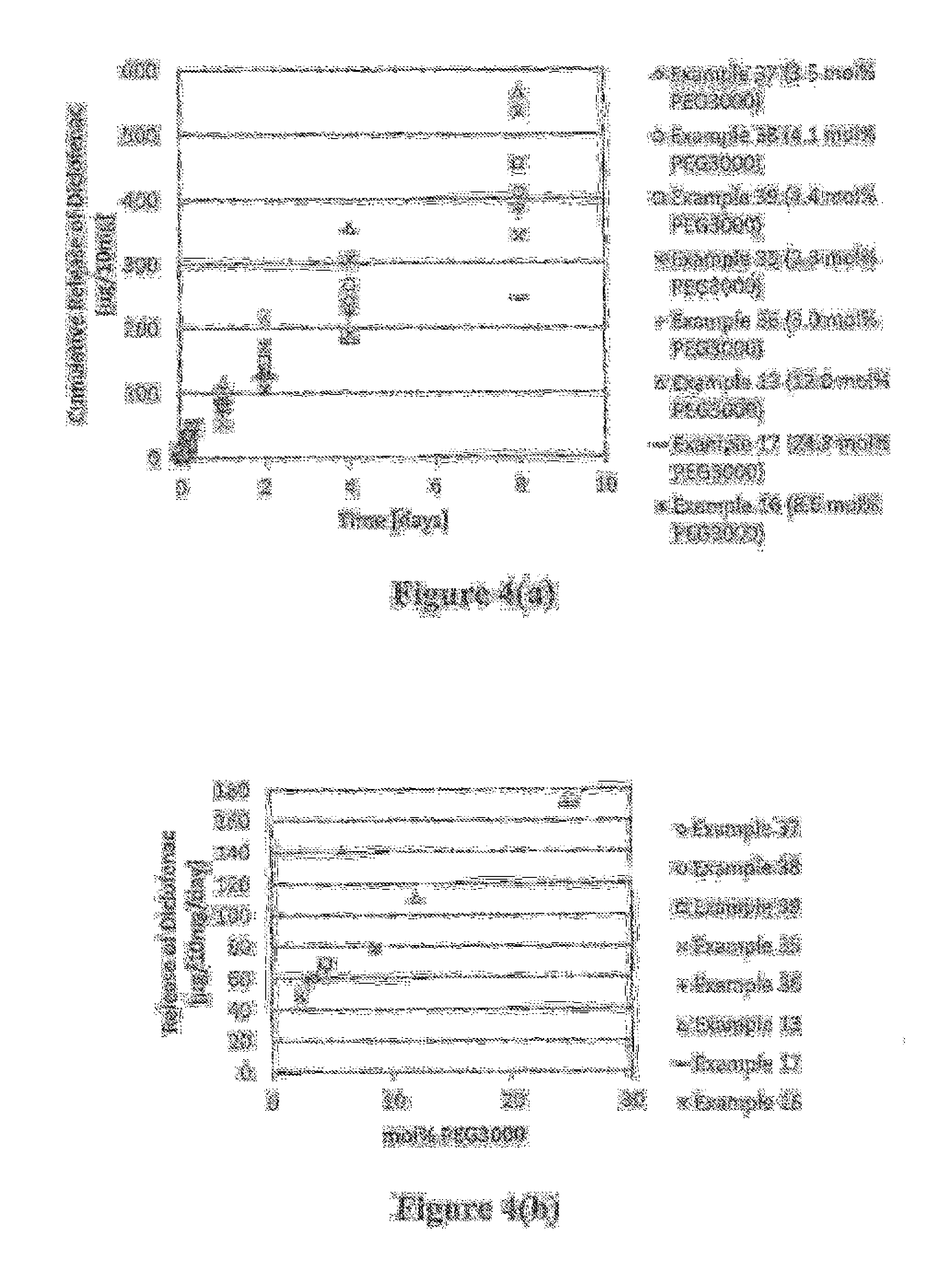Polymer-nsaid conjugate
- Summary
- Abstract
- Description
- Claims
- Application Information
AI Technical Summary
Benefits of technology
Problems solved by technology
Method used
Image
Examples
example 1
1,3-Dihydroxypropan-2-yl 4-(2-(2-((2,6-dichlorophenyl)amino)phenyl)acetoxy)benzoate (DCF-PHB-2-MG)
[0598]
a) The general procedure for DCC coupling (Procedure 3) was followed, using diclofenac (4.152 g, 14.0 mmol), DCC (3.713 g, 17.9 mmol), DMAP (0.191 g, 1.6 mmol) and 2-phenyl-1,3-dioxan-5-yl 4-hydroxybenzoate (Intermediate A) (4.239 g, 14.1 mmol) in anhydrous DCM. The crude mixture was purified via column chromatography on silica gel (20% ethyl acetate / hexanes, followed by 30% ethyl acetate / hexanes as eluent) to give 2-phenyl-1,3-dioxan-5-yl 4-(2-(2-((2,6-dichlorophenyl)amino)phenyl)acetoxy)benzoate in 62% yield as a white solid. 1H NMR (200 MHz, CDCl3) δ (ppm) 8.32-8.05 (m, 2H), 7.64-7.47 (m, 2H), 7.47-7.28 (m, 6H), 7.28-7.11 (m, 4H), 7.11-6.88 (m, 2H), 6.78-6.49 (m, 2H), 5.62 (s, 1H), 5.05-4.84 (m, 1H), 4.52-4.16 (m, 4H), 4.08 (s, 2H). 13C NMR (50 MHz, CDCl3) δ 170.05, 165.47, 154.41, 142.67, 137.68, 131.55, 131.03, 129.45, 129.12, 128.85, 128.32, 126.07, 124.17, 123.56, 122.37, 1...
example 2
1,3-Dihydroxypropan-2-yl 4-((2-(4-isobutylphenyl)propanoyl)oxy)benzoate (IBP-PHB-2-MG)
[0599]
a) The general procedure for DCC coupling (Procedure 3) was followed, using Ibuprofen (3.67 g, 0.0178 mol), DCC (4.77 g, 0.0231 mol), 2-phenyl-1,3-dioxan-5-yl 4-hydroxybenzoate (Intermediate A) (5.53 g, 0.0184 mol) and DMAP (0.324 g, 2.66 mmol) in anhydrous DCM (200 mL). The crude mixture was purified via column chromatography on silica gel (20% ethyl acetate / hexanes, followed by 30% ethyl acetate / hexanes as eluents) to give 2-phenyl-1,3-dioxan-5-yl 4-((2-(4-isobutylphenyl)propanoyl)oxy)benzoate in 71% yield (5.98 g) as a white solid. 1H NMR (400 MHz, CDCl3) δ (ppm) 0.90 (s, 3H), 0.91 (s, 3H), 1.60 (d, J=7.2 Hz, 3H), 1.82 (m, 1H), 2.47 (d, J=7.2 Hz, 2H), 3.92 (q, J=7.2 Hz, 1H), 4.24 (dd, J=1.6, 13.2, 2H), 4.39 (dd, J=1.6, 13.2, 2H), 4.94 (p, J=1.2 Hz, 1H), 5.61 (s, 1H), 7.08 (m, 4H), 7.29 (m, 5H), 7.52 (m, 2H), 8.03 (m, 2H).
b) The general procedure for benzylidene acetal / acetonide deprotectio...
example 3
2,3-Dihydroxypropyl 4-((2-(4-isobutylphenyl)propanoyl)oxy)benzoate (IBP-PHB-1-MG)
[0600]
a) The general procedure for BOP-Cl coupling (Procedure 4) was followed, using ibuprofen (0.402 g, 1.95 mmol), (2,2-dimethyl-1,3-dioxolan-4-yl)methyl 4-hydroxybenzoate (Intermediate B) (0.522 g, 2.06 mmol), BOP-Cl (0.518 g, 2.03 mmol) and triethylamine (0.55 mL, 0.40 g, 3.95 mmol) in anhydrous DCM (15 mL). The crude mixture was purified on the automated flash chromatography system using 0%-40% EtOAc in pet. spirit gradient elution to give (2,2-dimethyl-1,3-dioxolan-4-yl)methyl 4-((2-(4-isobutylphenyl)propanoyl)oxy)benzoate as a clear colourless oil in 75% yield. 1H NMR (400 MHz, CDCl3): δ (ppm) 8.13-7.99 (m, 2H), 7.38-7.27 (m, 2H), 7.22-7.11 (m, 2H), 7.11-7.01 (m, 2H), 4.50-4.39 (m, 1H), 4.39-4.26 (m, 2H), 4.23-4.02 (m, 1H), 3.94 (q, J=7.1 Hz, 1H), 3.85 (dd, J=8.5, 5.9 Hz, 1H), 2.47 (d, J=7.2 Hz, 2H), 1.94-1.78 (m, 1H), 1.67-1.56 (m, 3H), 1.44 (s, 3H), 1.38 (s, 3H), 0.92 (s, 3H), 0.90 (s, 3H). 13C...
PUM
| Property | Measurement | Unit |
|---|---|---|
| Hydrophilicity | aaaaa | aaaaa |
| Biodegradability | aaaaa | aaaaa |
Abstract
Description
Claims
Application Information
 Login to View More
Login to View More - R&D
- Intellectual Property
- Life Sciences
- Materials
- Tech Scout
- Unparalleled Data Quality
- Higher Quality Content
- 60% Fewer Hallucinations
Browse by: Latest US Patents, China's latest patents, Technical Efficacy Thesaurus, Application Domain, Technology Topic, Popular Technical Reports.
© 2025 PatSnap. All rights reserved.Legal|Privacy policy|Modern Slavery Act Transparency Statement|Sitemap|About US| Contact US: help@patsnap.com



